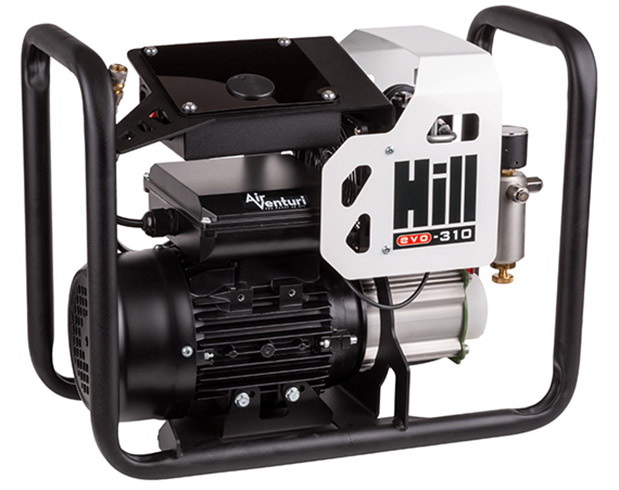
Air Venturi EVO-310 compressor by Hill.
This report covers:
- Needed a new compressor
- Not enough
- Let’s test it
- Digital display!
- How long?
- Shutoff
- Bleedoff
- Compared to the Krypton
- Not for everyone
- Not done
Today we begin a special report on a special air compressor—the Air Venturi EVO-310 compressor by Hill. This report will address things besides just testing the compressor, and if you are new to precharged pneumatics (PCP), this report is for you!
Needed a new compressor
I needed a new air compressor for filling large carbon fiber tanks and airguns with huge reservoirs like the Hatsan Factor Sniper Long we are testing. That rifle has a 700 CC air reservoir that fills to 300 bar / 4351 psi and just takes too long to fill with the RovAir compressor I also have. I will still use the RovAir to fill PCPs that have smaller air reservoirs, including the AirForce Condor that has a 495 CC capacity because that tank only fills to 3000 psi / 206 Bar.
I have been using an early version of the Air Venturi Krypton compressor that I bought used from Pyramyd AIR. It had about 50 hours use on it when I got it in January of 2017. It was fantastic and was used not just by me but also for filling tanks at the Texas Airgun Show for two years. I loaned it to Crosman one year to fill their carbon fiber tanks they used at the show, too. So it has had lots of use over the years. But not enough!
Not enough
To remain operational an air compressor needs to be used a LOT. And not just at one time, either. It needs to be used all the time to keep the seals lubricated. I told you in the report titled, Welcome to the world of precharged pneumatics (PCP) that I was the kind of shooter who has lots of PCPs and doesn’t shoot any of them often enough. I also said:
“This category of shooter can also create problems with his compressor(s). By filling carbon fiber tanks and then letting the compressor lie dormant for a long time the seals in the compressor can start leaking. The compressor needs to be used frequently enough to keep things lubricated and sealed.”
That’s what finally happened to my Air Venturi Compressor. I wasn’t using it often enough and it developed an oil leak. It now needs a reseal and I thought that was an ideal time to get the Hill EVO-310 compressor. This one has features that support my kind of intermittent use. Despite the fact that it was designed to fill PCPs directly, it will also fill large carbon fiber tanks. So let’s get started!
The Hill is quite a bit lighter than the Krypton because it is air-cooled, not water-cooled. But it was also designed to shut itself off during a fill whenever the compressor temperature goes over a certain level. In this instance it shuts off at 75 degrees C / 167 degrees F or less. The fan keeps blowing and when the temperature drops low enough the compressor starts up again.
You set the fill pressure you want and the compressor does the rest—including keeping itself cool. As the pressure builds up, the shutoff comes at a progressively lower temperature, so the compressor runs cool all the time.
Let’s test it
After an amazingly simple setup procedure (fill the crankcase with oil and a separate reservoir with silicone oil, both supplied with the new compressor) I connected it to a 98 cubic-foot carbon fiber tank and set the desired pressure of 300 bar / 4351 psi. Then I started the compressor.
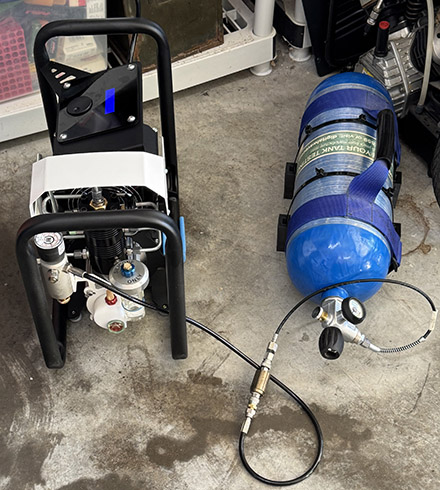
The EVO-310 is connected to a 98 cubic foot carbon fiber tank. That blue on top of the compressor is the digital display. The dark patches on the floor are where oil leaked from the old compressor.
This carbon fiber tank is one I used for the test of the AirForce Condor FATS, so I had used it some since it was last filled. It had 256 bar remaining when I started the fill—according to the digital display on the Hill compressor.
Digital display!
Yes, the Hill has a digital display. It shows the compressor’s operating temperature, the target fill pressure, the current pressure that being compressed and the number of hours the compressor has operated! That last one is so you can change the crankcase oil every 50 hours of operation or every year, whichever comes first. And Air Venturi, who represents Hill in the US, sells 50-hour and 100-hour maintenance kits!
The digital display has another great feature. It reminds you to check the two oil levels before you start the compressor.
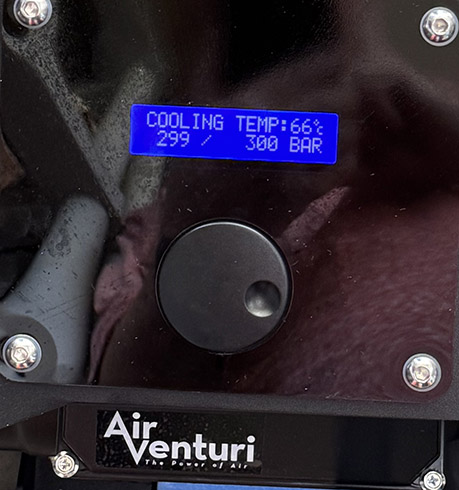
Here is the display at almost the end of the fill. The pressure in the system is on the left and the target pressure is on the right. The round knob is how all the controls are set.
How long?
To fill the 98 cubic-foot carbon fiber tank from 256 bar to 300 bar took 40 minutes and many compressor shutoffs. At each shutoff the compressor exhausted a small amount of air and water vapor. This is a set-and-forget compressor, though you do want to remain in the vicinity. I then filled a second 98 cubic-foot carbon fiber tank to 310 bar in about 30 minutes but that one had a little more air inside to start with.
I will normally not fill these big tanks with this much air. This was just a test. My plan is to refill my CF tanks after every use. That will give the compressor the workout it needs to keep it working well.
I plan to only fill the really big airgun reservoirs from the Hill directly because the RovAir compressor also needs its workout. The Hatsan Factor Sniper Long would be one candidate because it fills a 700 CC reservoir to 4351 psi / 300 bar. From empty to full took 22 minutes and several cycles.
I will note that the Hatsan male fill coupling is overly large and I had to search for a female coupling that would work. True Foster female fittings were too small, but the female quick disconnect from an Air Venturi G9 hand pump fit the Hatsan Factor coupling fine.
Shutoff
When the fill reaches the target fill pressure the compressor stops and waits to be depressurized and disconnected.
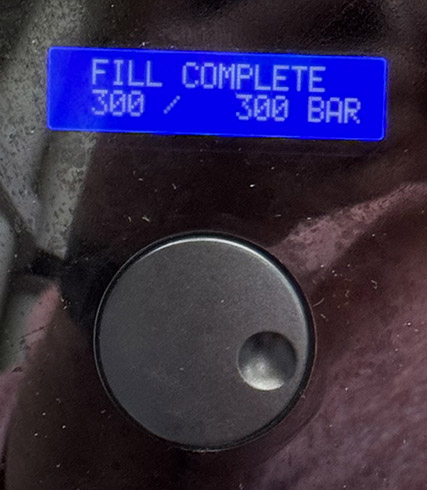
When the fill is finished the display lets you know.
Bleedoff
After the fill you bleed the compressor and this is where you see something else that’s neat. Remember that silicone oil tank we filled at the start? It’s been putting a small amount of oil into whatever is being filled, so as you fill your tanks or airguns they are being lubricated. Some comes out with the moisture when the compressor is bled. Will that revive some of my dry PCPs that no longer hold air? We shall see.
After the fill and bleedoff I ran the compressor fan another 15 minutes to drop the compressor temperature down to 41 degrees C. That’s something you should do with any air compressor.
Compared to the Krypton
The Hill fills slower than the Krypton. The water-cooled Krypton might have filled the tank in one-third the time or less. But the Hill is everything I need. I don’t have airguns and tanks that need filling often enough to keep a Krypton gainfully employed.
The Hill is both lighter than the Krypton and also about one-third the size. And it is much quieter. It is easier for me to maintain and keep operational.
Not for everyone
The EVO-310 compressor by Hill is not for everyone. If you shoot a lot and refill several carbon fiber tanks many times a month each, a Krypton compressor or other large air compressor might be better. That way your compressor will get the workout it needs.
My plan to refill the CF tanks after each use will keep the Hill operating longer and my fill times will be brief because I won’t be adding that much air. From this point on I will fill the CF tanks to 310 bar / 4500 psi. I just filled to 300 bar today to test all systems and learn how the compressor works.
Not done
This is not the last report of the Air Venturi EVO-310 compressor by Hill. Like I have with the Omega Supercharger, my early Krypton and the RovAir before, I will be telling you about this one in the time to come.
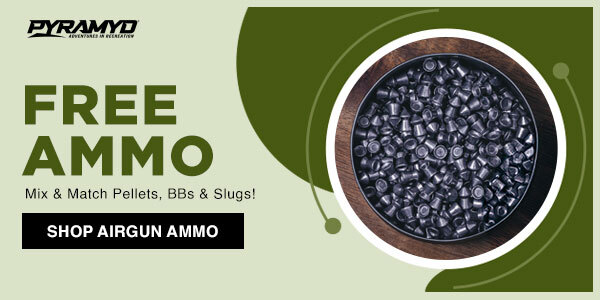
B.B.
Can the Hill Compressor be used tethered to an airgun?
-Yogi
I suppose it’s possible, but why would you?
Unless you just don’t want to move the gun to the compressor to fill it.
If you are wanting it to “top the gun off” automatically as you shoot, it doesn’t do that.
I have an older Hill Ec-3000 (a predecessor to the Evo) when it reaches the desired fill pressure, it stops the compressor, and leaves the fan running.
It will not start again until you bleed the pressure in the line, and start it again.
The digital display will even show the word DEPRESSURIZED, when you open the bleed valve.
That being said, if you pause the compressor before it reaches the preset fill pressure, it does let you resume the fill.
Yes you can pause the fill at any time, by pressing the dial interface.
And it then gives you the option to abort or resume the fill.
Ian.
Yogi,.
This answer is about what I would have written except 45Bravo has much more experience with this compressor than I do. So he said even more.
BB
Well if you are shooting a .50 caliber airgun, they run out of air very quickly!
-Y
Yogi,
Yes. When I tested the AirForce TexRex .51 caliber rifle I only got five good shots.
BB
Yogi,
I shoot up to .58 caliber airguns. I use Big Cylinders and a BIG (adjustable output pressure) inline regulator for sighting in my Big Bores.
I also doubt using a compressor would deliver a stable and impulse free enough supply of upstream air to an airgun valve or regulator to be useful.
shootski
I did not know that you shot larger big bore Airguns.
And I agree the compressor would not deliver stable pressures topping off the tank, as often as you would need.
That being said, if you had your tank on the ground or on the bench by you and the compressor feeding your tank and your tank feeding your gun, that would probably do what you are needing to do.
Two of my carbon fiber tanks, fill through the same foster fitting as it fills the gun.
My larger tank has a separate air input. It is a one-way valve from the compressor to the tank and then from the tank to the gun is a separate hose.
That set up would work.
Ian
45Bravo,
Ian. your use of one-way check valve(s) is a wise one that more folks should adopt.
Even though the reservoirs on all my Big Bores are tested to at least 9,000 psi (600+ BAR/62,052.82 kPa) i do not trust even my big in line regulator enough to not use an inline burst disk between the regulator and CASCADED large cylinder held at 3,600 psi (or less) and then on to my airgun. That setup has proven best to get my “cold bore” test shots to be the most reliable in approximating the in-the-field first shot results.
If there is one thing i have learned in my decades of experience with Hpa airguns is to respect the ability it has to do a great deal of damage to human flesh.
shootski
Tom,
How often should compressors be used to prevent the seals from going bad? Daily? Weekly?
Siraniko
PS Section Let’s Test It Picture 1 2nd sentence: “The dark patches on the floor are where oil leaved (leaked) from the ol (old) compressor.”
Siraniko,
I’m trying to use my compressor every two weeks. But even that is a chore because I shoot other guns that aren’t PCPs. And I also have the RovAir to cycle.
Fixed the errors you found. Thanks,
BB
“every two weeks”
Oh my! What about the hand pumps? Their seals want TLC too. Here is a thought (uh oh) that may help. Just run up some air pressure and exhaust the air like you normally bleed out moisture. Do this on all your compressors whether or not you actually use them to fill. While this is not much of a workout the seals at least get exercised.
Deck
Deck,
Yes, they do!
BB
That is what was suggested to me by Raptor Pneumatics, the company that makes the omega.
They suggest turning the compressor on every couple of weeks and let it run 5-10 minutes.
No pressure needed, just movement to “exercise “the seals.
Ian.
That’s a very nice and interesting compressor. I think that I would probably still add a drop silicone oil when filling guns. Especially if filling guns from the large carbon fiber tanks instead of directly from the compressor. I say that because I envision most of the silicon oil that might go into the large carbon fiber tanks staying in the tanks due to gravity. One thought is whether or not the filter would capture the small amount of oil discharged by the compressor.
I like all of the features, especially the operating time tracker. Looking forward to more reports about this compressor.
Elmer,
You make a Vewy good point!
BB
I think that this wascal knows about the HOA rule against shooting pellet guns in the neighborhood.
If it’s quiet enough…….
3 people can keep a secret…
If 2 of them are dead..
Or 2 dead rabbits…
It’s not about killing anybody, it’s about not telling anyone your business…
Ian.
BB,
Compressors are what make shooting PCPs such a joy, they eliminate the worry about running out of HPA. 🙂
Excellent advice about compressors: use them regularly, keep fluids topped off, let themselves cool down before unplugging.
To that I would add that I like to run my compressor for a minute or two without a load to allow it to warm up to operating temperature before putting any stress on it.
Hank
Hank,
I think I will add that to my routine. Thanks,
BB
I have had a pre-Krypton AV air compressor for several years now. I must be quite fortunate in that it has never given me any trouble.
I have it mounted on a garden cart so that I can easily move it around when I need to. I have also put an additional air filter on the output to insure the air is good and dry and clean. I use it to fill my very large CF tank. I have never used it to fill any of my PCPs.
From what I am reading here, I should probably exercise it much more than I do, but I have never had any problem with it with the exception of it not liking the cheap, Chinese rupture disks.
BB
An off topic thought that came up as I am trying to read and comment older blogs. Wouldn’t it be better if the most recent comments are on top? Just like recent news’ headlines. It could help those who want to leave a comment without having to scroll down all the previous ones.
Just a thought for a better readers’ experience.
Bill,
Sure. Who at Word Press would you call?
BB
BB
Obviously I don’t know the answer. That’s why I mentioned it. Maybe the IT experts in PAIR do, not me.
BB,
98 cubic-feet is nearly 3000 liters. Is that the volume of air at atmospheric pressure that’s required to fill the tank to its maximum operating pressure?
Bob,
Yep!
BB
BB,
Ah, I see. On this side of the pond the convention is to give just the internal volume of the tank itself. Thanks for the clarification
Bob Ryan,
There is at least one thing to remember about compressibility of air as compared to the Ideal Gasses that the Gas Laws are based on:
Above about 3,500 psi ( 248,21 kPa/250 BAR) the volume of Ambient (STP) Pressure air added will be reduced dramatically with increasing compressor/cylinder pressure.
shootski
PS: For those who have read the above the following are for additional consideration…
So in compressing air at very high pressure consider:
1. Oxygen ignition temperatures and adiabatic considerations with partial pressure.
2. Particulate contamination, oil mists, and deposits.
3. Weight of gas being delivered (molar volume) as well as just the pressure of gas
4. Pressure drop from storage pressure to required Working Pressure, Freezing, velocity
5. Water vapour Dew Point consideration.
B.B.,
Another great report.
I hope folks understand how much air pressure and volume doing your blog actually consumes.
For those thinking about getting a Hpa compressor i can only offer this from my experience of shooting a bunch with some REAL AIR HOG Big Bore Airguns:
If you have a reasonably nearby source of Hpa (Dive Shop, Paintball Shop, or Fire House) that can supply at least equal to, or a little higher, to your maximum fill pressure REQUIREMENTS you need to do some thinking about actual life cycle cost. I don’t use (don’t even own) a Hpa compressor but do have a CASCADE of four big bottles.
You get the biggest usage of air volume at your required pressure if you do it correctly. You only need two tanks to do a CASCADE to reap most of the benefit; the more tanks in the CASCADE the greater the efficiency. Depending on the volume of air you need you may not even need the super sized bottle like Tom’s pictured above or the four cylinders I primarily use.
Dry and pure hassle free (likely cheaper) Hpa could be yours using a CASCADE.
shootski